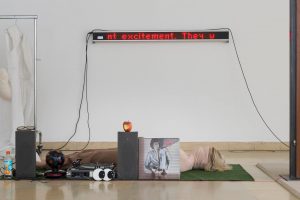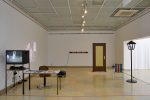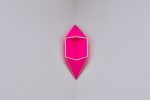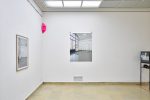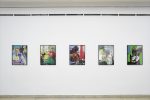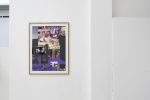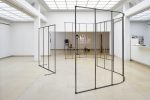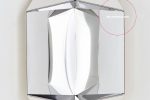Centerfolds
Stefanie Seibold

Centerfolds
Stefanie Seibold
Three steel sculptures resembling drawings stand in the central hall of the Kunstpavillon. Dividing it, they dynamize the hall with their curving forms, indicating the direction to visitors, creating new spaces while still remaining permeable.
In the collage The Architect (Lilly Reich), which hangs on the right in the entrance area, we rediscover the curving shape of the prototypes for these steel objects named after the song Joy in Repetition by Prince: embellished with silk fabrics, they once formed a display for an industrial fair in Berlin during the 1920s. Lilly Reich, a contemporary (and co-worker, even for some time a life partner) of the famous architect Ludwig Mies van der Rohe, assisting him frequently without due acknowledgement, was the designer of these smart settings in which, among other things, we can see the steel tubing furniture and “free swinger” chairs typical of the Bauhaus. We assume that the woman with a hat visible in an integrated black and white photograph is the architect herself. But the woman in contemporary look at the right-hand edge of the picture – artist Maruša Sagadin – also studied architecture. So what do the acclaimed US pop star who died in 2016, the formal language of the 1920s, other paravent-like architectures, a historically under-represented female architect and designer, and her fellow artist all have in common?
For long periods of time Stefanie Seibold collected materials for her research, which – as the artist herself has put it – were simply waiting to be condensed into collages, installations or performances. More collages produced between 2013 and 2018 are presented in the left-hand wing, clarifying this approach and featuring genealogies of women in art history. Seibold presents her gallery of ancestors or chosen family here, joining the series herself – wearing a clown’s wig – in Untitled (Self-Portrait with Masks). The images range from a young artist sunken in melancholy and thus reminiscent of Degas’ Absinthe Drinker to Virginia Woolf, who was long underestimated in literary studies according to Seibold, and even to the Venus of Willendorf.
By contrast to the reduced formal language of the Joy in Repetition sculptures, the collages are sumptuously full, sensual and full of erotic innuendo. A courtly Baroque painting showing a lady, with a kitten at her feet, as she gathers up her skirts to fasten a suspender meets the performers of Japanese kabuki theatre, in which all roles are played exclusively by men, or a mouth-blown Venetian glass lamp that bears astonishing resemblance to an ample female bosom. The collages appear associative but they have been meticulously arranged by Stefanie Seibold; they examine queer-feminist issues but also questions of space. Thus, for example, the prints Untitled (Self-Portrait with Masks) and Untitled (The Absinthe Drinker) are also part of her research into paravents, which goes hand in hand with questions of showing and concealing. In both, it is also possible to find additional examples of folding, by which a freestanding three-dimensional object can be created from two-dimensional material in only a few steps. Behind the model of the yellow paravent on the artist’s self-portrait as a clown, an androgynous woman with short haircut and simple black polo-neck jumper appears. It is the German minimal artist Charlotte Posenenske, who was only appreciated more fully after her death; she always made her objects from everyday materials, often those used in industrial production. Another “foremother”. Drawing from the source of art history and with great connoisseurship, Stefanie Seibold poses seemingly simple questions such as “How did space enter the image?” and opens for discussion the interrelations of space, representation and person.
The series Centerfolds is presented in the form of four photographs and lends its title to the entire exhibition; here, Seibold has created objects in a Minimal look, whose initial effect is that of precious things although in reality their original form is folded from cardboard and shiny foil. A precursor series to these angular objects was significantly entitled “Because Diamonds Are A Girl’s Best Friend”. Two three-dimensional, angular objects in neon colours – the artist also speaks of bonbons in this case – are placed at the front and the rear of the space, so creating a connection between the groups of work, and simultaneously standing out through their signal colours and positioning. The title of the exhibition Centerfolds is equally ambivalent. It could refer to the folded objects, but the dictionary definition makes the sexual connotation obvious: “Centerfold” means “a nude photograph of a person appearing across the centre pages of a glossy magazine.
Clever Gretel
Incorporated into this setting comprising recent and brand-new sculptural works and collages, in the back room of the Kunstpavillon, there is the stage for Stefanie Seibold’s performance Clever Gretel premiered in 1999 and re-enacted in the context of the individual exhibition. The original performance is shown as a video, which will be supplemented by documentation of the re-enactment after live presentations on 14th and 15th September.
Clever Gretel is based on the droll story Clever Gretel by the Brothers Grimm, which is not so much a fairy-tale as a burlesque. Gretel is a cook who enjoys a drink, and plays her master and his guest off against each other with a cheerful lack of morality. Stefanie Seibold sees this early work as representing a leitmotif in her artistic production, which at that time already combined heterogeneous forms of expression, being a collage of collected and sampled gestures and texts from science, popular and high culture. Pioneer of dance Martha Graham is quoted alongside gender researcher Donna Haraway, boxer Leila Ali, and obituaries from the New York Times, as well as artist Mariko Mori or writer and artist Kodwo Eshun. Paper bags from the Freud Museum mark the positions in which Freud’s studies on humour, the subconscious, sexual therapy and hysteria are thematized. The subject “Clever Gretel” is embodied by three performers simultaneously, and rules and regulations inscribed into the body are subversively questioned and sabotaged. The performance is based on the “fundamental question of ‛women’s’ position and involvement in art history and in the world” (Seibold) and attributions of gender are also opened to debate. Whether in one scene the performers embody feminine Gretels or heavy metal Viking-dudes, for example, is left intentionally unclear. Stefanie Seibold says: “The situations in which the three performers find themselves often seem to make no sense at first glance; examined more closely, however, they represent a sequence of situations that analyze with extreme precision how, and by what means, subjects are being produced as female, or rather are supposedly constituted as such through processes of standardization.” Not only the artist and the performers, but also the audience can look forward to seeing how these queer-feminist moments of opposition, which operate against such subjectivization, are read and interpreted almost 20 years after the premiere.
To shed light on the differences and continuities in her many years spent investigating space, object and body is Stefanie Seibold’s central interest with Centerfolds. Another feature of her work is an approach employing as much energy, humour and enjoyment as it does meticulousness. Clever Gretel!
Ingeborg Erhart
